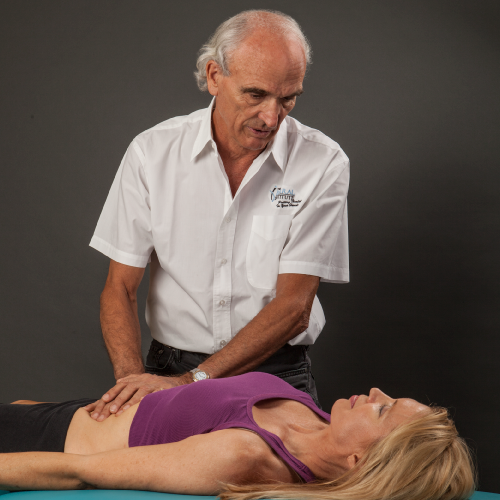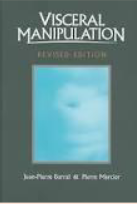Level 1 of the Visceral Manipulation Education Program of the Barral Institute
VISCERAL MANIPULATION: ABDOMEN 1
• The only official training course of the Jean-Pierre Barral method in Hungary
• The fundation course of the training series
• Practical and effective techniques
• A non-invasive method that can be used immediately

About the training
Visceral Manipulation (VM) was developed by world-renowned French Osteopath Jean-Pierre Barral. Visceral Manipulation: Developed by him, Abdomen 1 (VM1) is the base of the education program providing a thorough insight into the basic principles, theories and techniques of the method.
Each higher level of the education program deals with parts of the body in more and more details, enriching the participants’ knowledge by more and more sophisticated techniques. All levels of the program contain several practical and very effective techniques which can be immediately applied in the participant’s professional practice.
VM1 puts great emphasis on the development of sensible tactile skills, as palpation is of vital importance in Visceral Manipulation therapy. In order to master the palpation skills, participants need time and practice. Therefore, different skill levels can be learnt in each course, according to the participants’ advancement. VM1 focuses on the ability that helps distinguish the different types and layers of visceral tissues. Participants gradually learn to reach the deep tissues in a non-invasive way, and also to understand what they feel.
Instructor
RITA BENAMOR
Doctor of Osteopathy, (Portugália)
BI-D, CST-D
Graduated in Osteopathy from Oxford
Brookes University
22 years of clinical experience
Official instructor of 10 different courses
at the Barral Institute
Director of the Barral Institute Portugal
since 2016
Teaching in 4 different languages in
around 20 countries

Rita Benamor

Elekné Varga Orsolya
Teaching Assistant
Elekné Varga Orsolya
physiotherapist, Maitland
manualtherapist, CST-T
trained in various fascia techniques
ADV2 craniosacral therapist
experience as a student in 5 other countries
teaching assistant since 2019
Head of the Barral Institute Hungary
since autumn 2024
THE DATE OF TRAINING
1-4 Febr, 2025
Application deadline: 1st Jan, 2025
LOCATION
Budapest or Budaörs
COURSE DURATION
| Day 1: | Registration Course | 08:30-08:55 09:00-18:00 |
| Day 2: | Course | 09:00-17:30 |
| Day 3: | Course | 09:00-17:30 |
| Day 4: | Course | 09:00-16:00 |
The schedule of the course is subject to change. Courses may run late each day, in order to be able to cover all the topic planned for that day..
COURSE FEE
With Early bird discount:
(If the full participation fee is received by 31 Dec, 2024)
750 EUR
From 1st Jan, 2025
800 EUR
Including VM1 Study Guide, excluding
food, lodging and transportation.
For repetitors
450.00 EUR
FURTHER COURSE HIGHLIGTS
Techniques to identify the anatomical components and connective tissues belonging to them.
1. Differentiating several tissue qualities such as: tone, elasticity, expansiveness, fibrosis (if present)
2. Motion, mobility and motility
3. The reaction to inducement, and the functional connection with other tissues of the body.
In order to learn these techniques, participants receive detailed anatomical and functional-mechanical information referring to each organ.
Learning Visceral Manipulation starts with the abdomen, as this is the biggest among the visceral cavities and the easiest to access. To abdominal organs belong: liver, stomach, gallbladder, bile duct, duodenum, small intestine, large intestine and the tissues connecting them. Higher levels of the education program deal with the posterior abdominal organs, the pelvic organs, the thoracic organs, and the cranial viscera.
The course presents the methods of examination: ‘general listening’, ‘local listening’ (general and local examination), motility, examination of mobility and inhibition techniques. With the help of these methods the parts of the body with the greatest tension can be located. The above-mentioned techniques are global, including all systems and tissues of the body. Techniques are presented to determine the exact areas of pathological function. The casual links between visceral blocks and somatic function disorders can be observed.
COURSE TOPIC
1st Day
Introduction, Concept and Theory
- History and basics of the visceral concept, its significance in manual therapy
- General anatomy and physiology of the thoracic and abdominal organs.
- Their connection with the musculoskeletal system, nervous system, vascular system and digestive system
- Principles of visceral techniques-organ specific fascia mobilization.
- General principles of the fascia, the mechanical connecting system of the organs.
- Discussing and explaning contraindications.
- Latest research on the relation of the internal pressure of the body, the visceral motion and the restrictions of the soft tissues.
Liver/Presentation/:
- The liver, and its connection to the diaphram and to other viscera.
- Anatomical reference points, sliding surfaces, normal liver mobility referring to the three anatomical planes. Hepatic fixation,
- Present theories of mobility and motility. Present techniques of the correction of mobility disorders, hepatic fixation
2nd Day
Stomach /Presentation/:
- Anatomical description
- General description of stomach mobility
- Manipulation techniques relating to the stomach (direct and indindirect techniques)
- The motility of the stomach;
- Palpation and manual examination of the pylorus
Examination Skills/‘Listening’/:
1.’General Listening’ (general examination),
2. ‘Local Listening’ (local examination),
3. ‘Inhibition’
Stomach:
Its manual examination and treatment
- treating the lowering of the stomach;
- manual examination and treatment of stomach ulcer
3rd Day
- leocecal valve, duodenojejunal flexure,
- Oddi, pylorus, cardia
- Duodenum: (D1) and its relation to the liver;
- (D2) and its relation to the common duct and the Sphincter of Oddi; Sphincters;
- (D3) and its relation to the mesenteric root, treatment and examination of duodenojejunal flexure
- Mesenteric root and small intestine; test, examination and treatment of mobility
- Gallbladder: Exact anatomical description of the gallbladder and its duct system, including the common bile duct, and the Sphincter of Oddi; Third level of gallbladder manipulation (1. Body/fundus and neck of the gallbladder, 2. Cystic duct, 3. Stretching of the common bile duct);
- Manual examination of the sphincters and the body of the gallbladder,
- Differentiation between the liver and the gallbladder.
4th Day
- Small intestine
- Coecum (Appendix)
- Ascending colon
- Descending Colon
- Hepatic Flexure
- Splenic Flexure
- Transverse Colon
- Sigmoid Colon

RECOMMENDED READING
Jean-Pierre Barral, RPT, DO: Visceral Manipulation
Frank Netter, MD: Atlas of Human Anatomy
Carmine Clemente: A Regional Atlas of the Human Body
